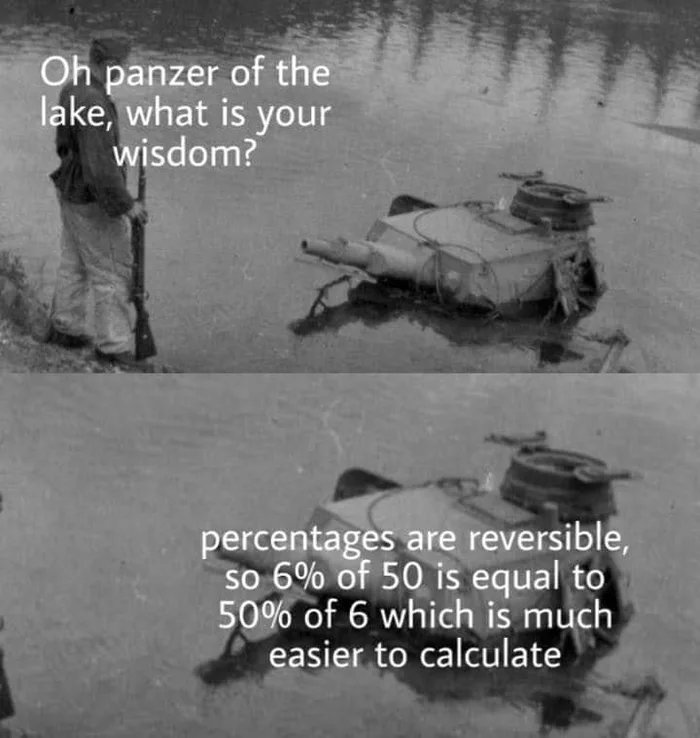this post was submitted on 09 Nov 2023
1369 points (98.1% liked)
Memes
47100 readers
1338 users here now
Rules:
- Be civil and nice.
- Try not to excessively repost, as a rule of thumb, wait at least 2 months to do it if you have to.
founded 5 years ago
MODERATORS
you are viewing a single comment's thread
view the rest of the comments
view the rest of the comments

WTF why did no one mention this to me when I was struggling with math as a kid?
They probably did, just not explicitly:
You could write (6*1/100)*50 = 6*(50*1/100)
It only uses the commutative property of multiplication and the fact that % is another way of writing 1/100.
Maybe also worth remembering that "x% of y" is just x/100*y
I'm confused again.
The word percent is exactly that per cent, which basically means parts of hundred. E.g. 10% are 10 of 100, or 60% are 60 of 100. You can also write this mathematically as 60/100 or 60÷100, which is 0.6.
Now in general: x% are x parts of 100 or x/100 or x÷100. If you want to calculate x% of y you just multiply it: y × x% = y × x ÷ 100.
This is one of those "maths is magical" moments, I guess.
Mathemagics.
By what part?
I totally remember being taught this. It's just way easier to break down percentages in terms of the nearest 1% or 10% times the number in the percent times the number you're taking the percentage of. You don't have to do the math for the 1 or 10 percentage as long as you remember that a 10% means move the decimal left once and 1% means move the decimal left twice. The rest is just basic multiplication.
40% of 59 = 10% of 59 times 4.
So...
4x59=236
or
(4x50=200) + (4x9=36)= 236
10% means move the decimal left once,
Therefore 40% of 59 is 23.6
With that you can easily do more complex percentages mentally like...
62% of 35 = 10% of 35 times 6 plus 1% of 35 times 2.
35x6=180+30=210 at 10% so 21
plus
35x2=60+10=70 at 1% so 0.7
Therefore 62% of 35 = 21.7
While I get your sentiment, I'm always baffled how people fail to just memorize some basic formulas/equations and then just to plug and play:
1÷kⁿ = k⁻ⁿ
% = 1÷100 = 10⁻²
k×10ⁿ equals k with its floating point shifted by n to the right for positive n, or to the left for negative n
That's really all one needs to know for the "problem" at hand. For your concrete example of "40% of 59" that would just be
59×40×10⁻²
Just solve that whatever way is easiest. I don't get why people get panic-stricken when they see the % sign.
Seriously, why didn't anyone?! Would have made my life much easier.
they absolutely taught you the commutative property and transitive property
Yeah but they clearly taught it poorly
They taught you all the parts. Where they (and I’d agree most math education) failed was to connect the dots.
They taught you about these properties.
They taught you that division is just fractions and vice versa.
They taught you that x/1=x.
They taught you multiplying fractions as (numerator_a • numerator_b) / (denominator_a • denominator_b).
They taught you percentages are just “per centum”, or per hundred, or basically just a fraction “over 100”.
But these tricks, much like many other mental math shortcuts that are useful for everyday life, got glossed over or missed entirely.
Easy way to do %
Say you want 6% of 45
Seems hard right?
1% of 45 is .45
.45 × 6 =
.4 × 6 = 2.4
.05 × 6 = .3
2.4 + .3 = 2.7
So 6% of 45 is 2.7
Extra:
Say you want an item that is 40 dollars and it is 20% off.
10% is 4 dollars.
20% is 8 dollars.
So item would be 32 dollars.
that's a shitload of lines of math to write out/work in your head. I learned percentages of x as: 6 * 45 / 100 = x (2.7) If you picture both as fractions, you multiply the opposite and then divide by the other number to get the missing one (x). Hopefully Lemmy renders this well...
The way I learned it was multiply diagonally and then divide by whatever is opposite diagonally to x.